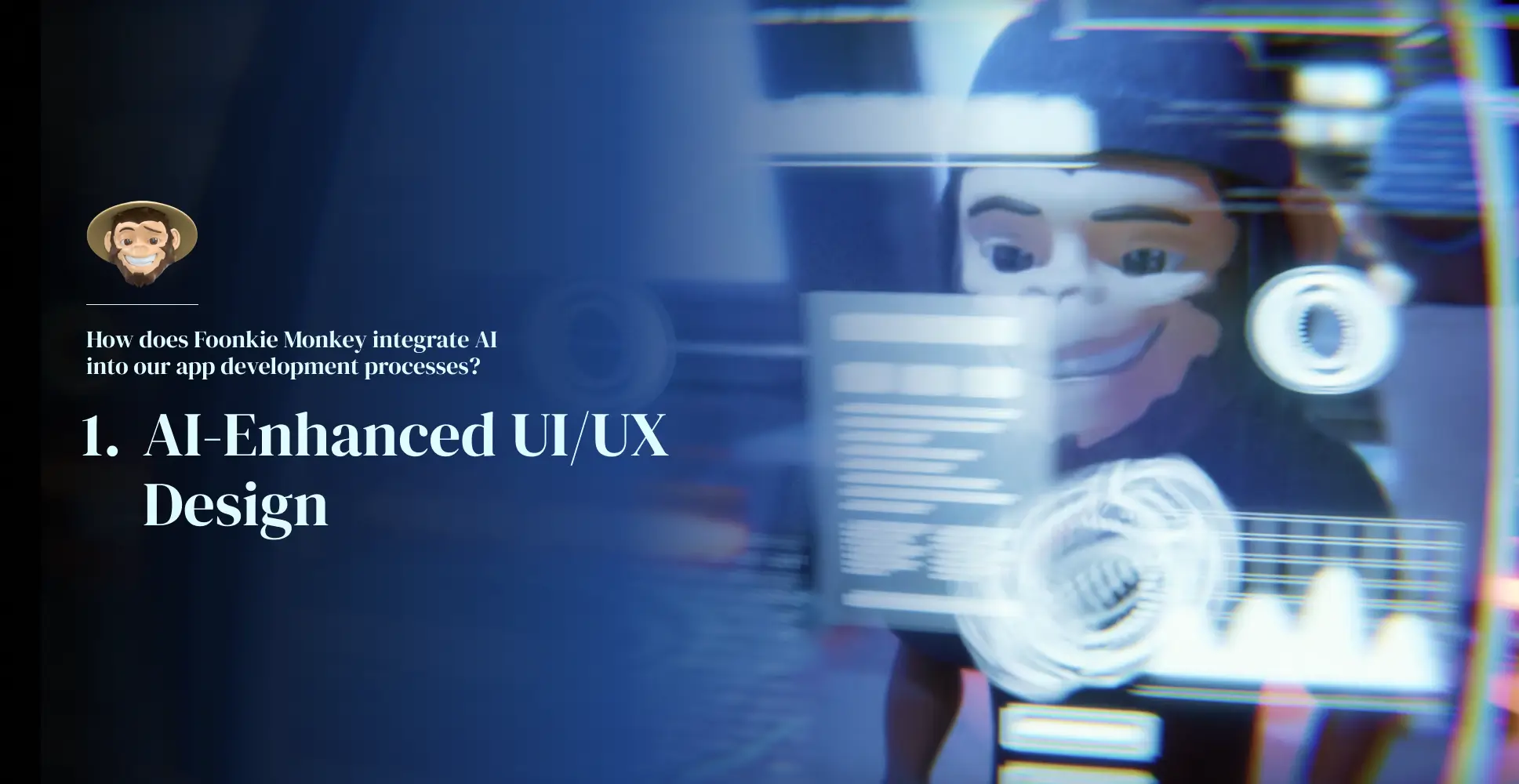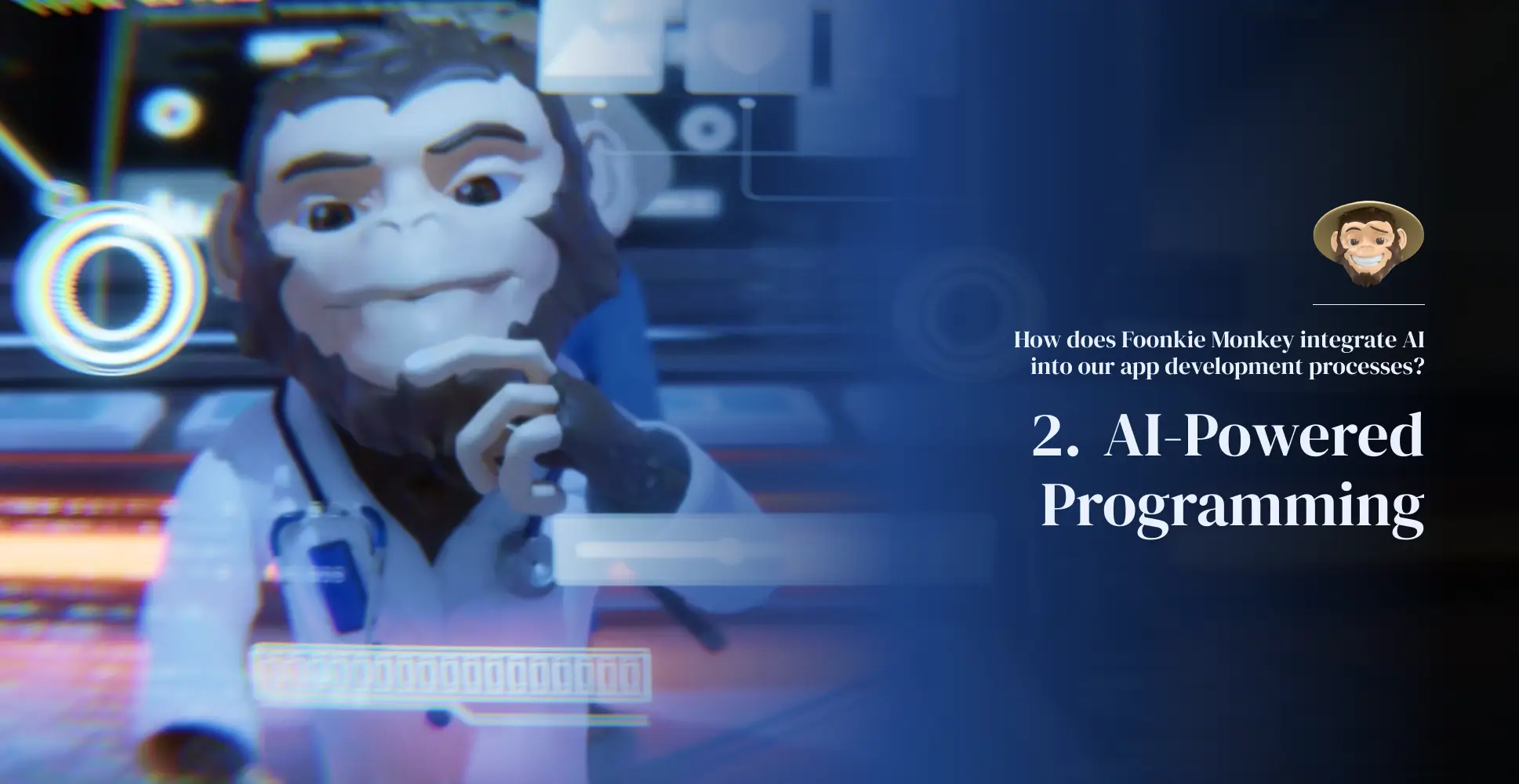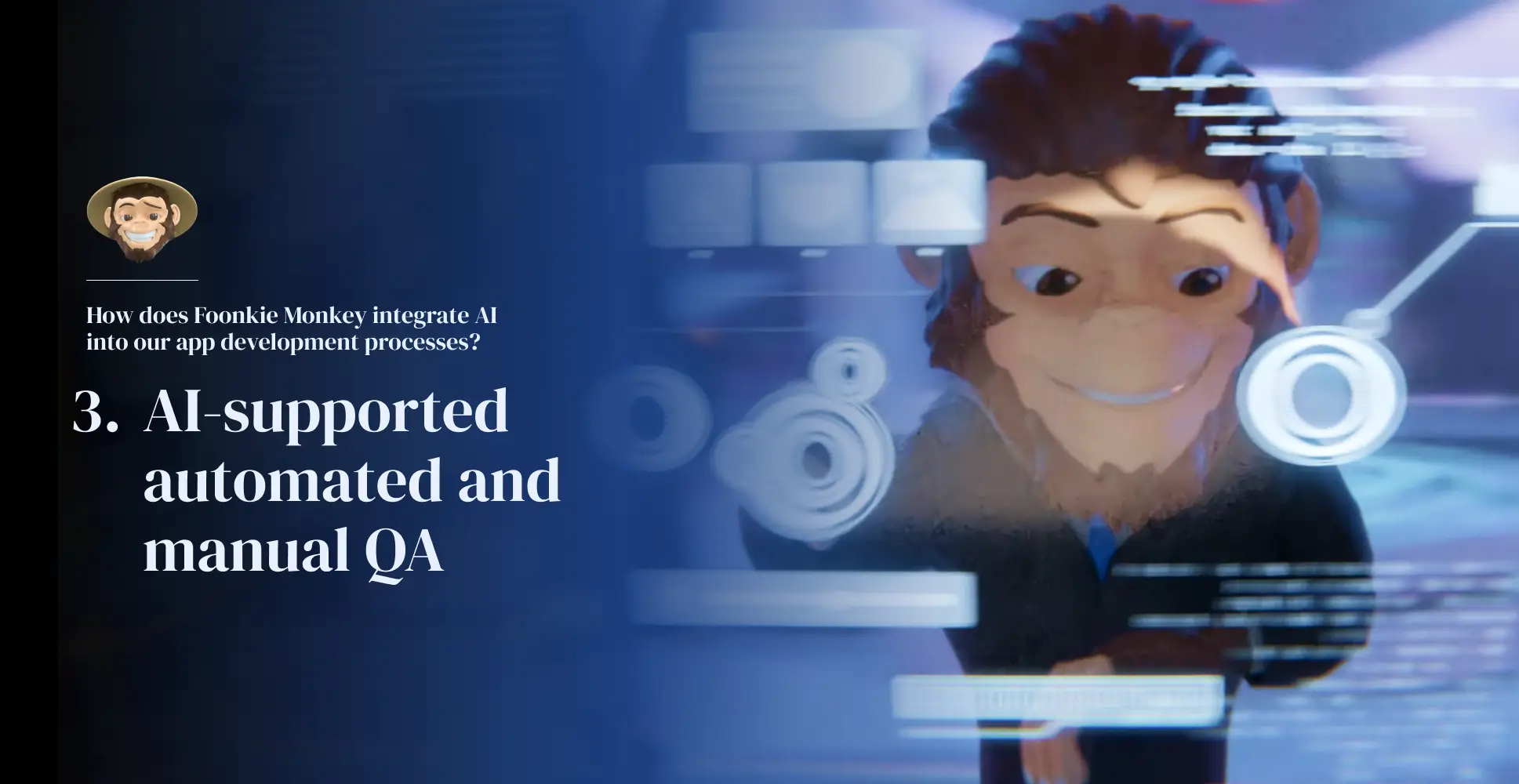AI is transforming the world across nearly every industry. It is undeniably reshaping how we live and interact, and app development is no exception.
Artificial Intelligence has rapidly become an integral part of our daily lives, transforming how we work, shop, exercise, and even consume music. Its influence extends beyond personal conveniences—it is fundamentally reshaping industries, including app development. AI is no longer just a luxury; it is a necessity in modern software creation. Developers are leveraging AI to automate tedious tasks, streamline workflows, and enhance user experiences with smarter, data-driven solutions. As AI continues to evolve, it is making app development faster, more efficient, and more innovative, expanding the possibilities of what digital applications can achieve. At Foonkie Monkey, we are at the forefront of this revolution, leveraging AI capabilities to push the boundaries of app development and redefine industry standards.
By embedding AI in most of our app development processes, we have started to redefine workflows, drive automation, and leverage smart testing practices to not only deliver faster, more cost-efficient, and higher-performing apps but also to eliminate bottlenecks, reduce human error—all while maintaining cost-effectiveness and high performance without an increase in costs or workload.
In this article, we’ll take an in-depth look at how Foonkie Monkey is harnessing AI to revolutionize app development and why this technological shift is setting a new benchmark for efficiency, quality, shorter time-to-market, cost-savings, and innovation in the industry.

How does Foonkie Monkey integrate AI into our app development processes?
1. AI-Enhanced UI/UX Design
Traditionally, our UX/UI design processes leaned heavily on manual research and extensive user testing. While these methods remain highly valuable to us, and we still use them depending on the context and needs of the projects, the truth is that integrating AI-driven tools into our UX/UI design processes has allowed us to push beyond conventional limitations and enhance the usability, efficiency, and design precision of our projects without increasing costs or workload on designers.
We leverage advanced AI tools throughout our UX/UI process, ensuring that every app we design is not just aesthetically appealing but also functionally optimized for the best possible user experience. Here’s how we use AI to optimize UX/UI design:
FlowMapp: Our UX designers have started defining sitemaps, user journeys, and information architecture using FlowMapp. By inputting the project and the user’s needs and information, this robust UX designing and planning AI-powered tool now helps us to:
Structure intuitive sitemaps for seamless navigation.
Develop editable wireframes that align with user behavior patterns.
Optimize content hierarchy to enhance accessibility.
Instantly map out robust user journeys and navigation flows.
Midjourney, ChatGPT, and Perplexity: These AI tools help us generate detailed user stories and personas based on the needs and functionality the application requires. They help our designers analyze user behavior patterns and industry trends to create optimal scenarios that drive more focused design choices and ensure a user-centric approach.
Attention Insight: This powerful AI tool helps our UX/UI designers optimize designs by predicting where users will focus their attention. Attention Insight creates AI-driven heatmaps and simulated eye-tracking data that allow us to optimize element placement, ensuring that call-to-action buttons and key features are strategically positioned.
Figma AI: In the final design phase, we typically use Figma for prototyping and wireframing, but now, with Figma AI, our designers can automate countless repetitive design tasks such as and access real-time suggestions, creating visually stunning interfaces that are also highly functional in a fraction of the time. We use Figma plugins such as Banani, FigPilot, DALL-E Bro, and Icons8. These help access free features to create icons and screens and leverage ChatGPT for text generation, image generation, and background elimination.
Uizard: Enables us to quickly transform our ideas into high-fidelity UI prototypes, dramatically reducing design iteration time.
Relume.io: Relume helps us streamline style guide generation, allowing us to build responsive, production-ready interfaces in a fraction of the time.
UXpilot: This powerful AI tool allows our UX/UI designers to generate UX designs that are validated and optimized for real-world performance.
The result? By incorporating these AI-powered tools in the most critical and repetitive parts of our UX/UI design process, we’ve slashed wireframing time from two weeks to just 1–2 hours—accelerating ideation without sacrificing quality. We have also managed to write user stories and create complete style guides in hours rather than days, reducing the overall time of our UX/UI design process by around 40%! This increased efficiency doesn’t just save time; it frees our designers to focus on creativity while supporting faster delivery, smarter iterations, and higher-impact designs.
Foonkie Monkey’s added value: While these and many other AI tools can deliver valuable, data-backed UX/UI design elements in minutes, the truth is that manual labor and human touch remain indispensable components of our development processes. Although AI-generated design elements can be effective for smaller projects, they often lack the depth and customization required for more complex applications. Our UX/UI designers bring a unique blend of creative judgment, empathy, and expertise that AI systems cannot replicate. So, by skillfully integrating AI-generated data with their own human insight, our designers craft interfaces that are both technically sound and emotionally resonant with users. This harmonious blend of automation and human creativity not only enhances the design quality but also reduces design iterations, manual workloads, and costs, ultimately leading to more efficient and impactful design solutions.

2. AI-Powered Programming
While programming inherently involves repetitive tasks such as following established patterns, structures, and rules, Foonkie Monkey’s development team is transforming this reality. We’re automating mundane coding tasks by strategically implementing AI-powered tools, revolutionizing our debugging process, and elevating overall code quality. Here’s our innovative approach to AI-supported programming.
Code Assistance: Our team utilizes tools such as ChatGPT, Gemini, CODEIUM, and GitHub Copilot to assist with repetitive tasks. These tools provide real-time code autocompletion, predict subsequent lines of code based on context, and help with tasks like function generation, recommendations, class creation, and code refactoring. By leveraging the code context provided by our developers, these AI-powered assistants offer recommendations that not only accelerate the coding process but also reduce errors. As a result, we achieve a more efficient, clean, and maintainable codebase, ultimately speeding up project delivery.
Debugging and error detection: Our team of developers leverage IDEs (Integrated Development Environments), such as Visual Studio Code and JetBrains Rider, that are equipped with AI-based capabilities that offer robust debugging tools. These AI-based tools help identify potential bugs and optimize code performance, which is one of the most time-consuming processes of programming, helping minimize downtime and ensure that applications run smoothly in real-world environments.
Streamlined documentation and commit management: Writing documentation is a crucial yet repetitive task for our app developers. Fortunately, they can leverage AI tools like ChatGPT to automatically generate documentation based on code changes. This helps in managing commits, saving time, and ensuring that every update is clearly recorded and traceable.
Database optimization: For tasks involving database management and optimization, which can also drag out, our team relies on tools like Datagrip, which help optimize databases, identify inefficiencies, and ensure that data retrieval is both fast and secure.
The result? We have integrated advanced AI tools into our programming workflows, resulting in an estimated 30-50% reduction in overall programming time and some specific tasks, such as debugging, as much as 90%. These time-saving benefits have enabled us to consistently deliver high-quality applications while continually improving our coding practices without increasing the workload or sacrificing efficiency.
Foonkie Monkey’s added value: Yes, these AI tools have significantly boosted our team’s efficiency by automating most repetitive tasks. Still, our expert programmers remain at the core of our development process. Their unique ability to interpret AI-generated recommendations, tailor solutions to meet our client’s unique needs, and ensure that the final product aligns with strategic objectives is irreplaceable. This combination of human ingenuity and creativity and AI-driven automation results in software and mobile applications that are not only developed faster but are also more robust, scalable, and highly secure.

3. AI-supported automated and manual QA
Quality assurance is a vital part of all our development processes. We have begun using AI tools to support our testers, enhancing both their manual and automated QA practices. This ensures that our applications are more robust and secure. Below are the tools we have successfully implemented.
For manual QA
- User stories: For manual QA, ChatGPT, and Copilot have helped expedite the redacting of comprehensive user stories and have proven valuable in generating a wide range of test cases and case data that we may have missed and that help us ensure we cover a wide range of real-world interactions.
For automated QA
Logic verification: ChatGPT also helps our QA specialists ensure the logic of the tests by scanning through code to pinpoint logical inconsistencies and potential errors, ensuring that all functionalities operate as they should.
Features redaction: AI systems can also help us detect subtle bugs and fissures in the code, allowing us to understand them better, intervene, and fix them before deployment, speeding up the testing process and improving overall application stability.
Continuous test monitoring and support: AI tools support us in monitoring the performance of applications in real time, providing actionable insights and instant feedback on potential issues that may impact the user experience.
The result? Integrating AI into our quality assurance (QA) processes has accelerated our app development while consistently delivering superior, innovative, and error-free applications. This strategic combination of technology and expert human insight has enabled us to optimize our QA procedures, reducing the time spent on redacting user stories by 30%, cutting test case creation time by another 30%, and increasing test coverage by nearly 40%. These improvements ensure our clients receive high-quality, scalable, and secure digital solutions.
Foonkie Monkey’s added value: AI has revolutionized our quality assurance (QA) processes, both manual and automated, by streamlining repetitive tasks and speeding up error detection. However, the human element remains essential. Our QA specialists utilize AI-generated data to thoroughly validate complex test scenarios, applying their creative problem-solving skills to address issues that automated tools may miss. This collaboration between advanced AI capabilities and expert human oversight ensures that every application we develop meets the highest quality standards, delivering reliable, secure, and user-friendly digital solutions.

Final Thoughts
At Foonkie Monkey, we believe the strategic integration of AI and expert human oversight throughout the app development process is a game-changer, driving unprecedented efficiency and precision. By harnessing state-of-the-art tools for UX/UI design, programming, and quality assurance, among other processes, we have not only started to reduce app development time and costs but have also managed to consistently keep delivering robust, innovative mobile and software applications. This innovative blend of AI’s efficiency and our team’s human creativity and sensibility ensures that every product we build is future-proof, secure, and optimized to meet the evolving demands of the digital landscape.
At Foonkie Monkey, we embrace emerging technologies and have started to lead the next generation of app development powered by AI. If you have any questions or want to implement AI-based app development in your next product, let’s talk!
